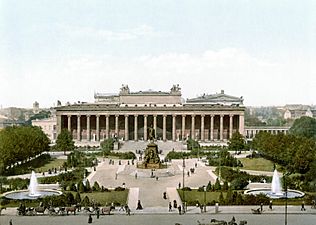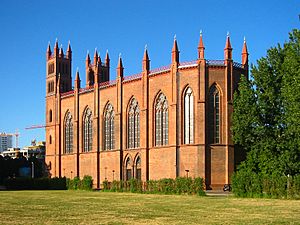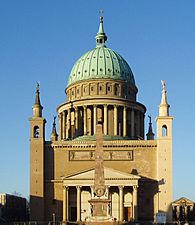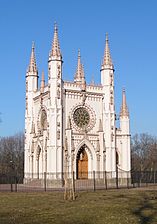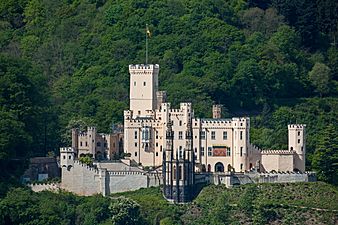Karl Friedrich Schinkel facts for kids
Quick facts for kids
Karl Friedrich Schinkel
|
|
|---|---|

Schinkel in 1836:
by Carl Joseph Begas |
|
| Born | 13 March 1781 Neuruppin, Margraviate of Brandenburg
|
| Died | 9 October 1841 (aged 60) Berlin, Province of Brandenburg
|
| Nationality | German |
| Occupation | Architect, city planner |
| Known for | Neoclassical and neogothic buildings |
| Signature | |
 |
|
Karl Friedrich Schinkel (born March 13, 1781 – died October 9, 1841) was a famous German architect, city planner, and painter. He also designed furniture and amazing stage sets for plays. Schinkel was one of Germany's most important architects. He created buildings in two main styles: Neoclassical and Neo-Gothic. Many of his most well-known buildings are in and around Berlin.
Contents
Schinkel's Early Life and Training
Schinkel was born in Neuruppin, a town in Germany. When he was six years old, his father died in a big fire that destroyed much of Neuruppin in 1787.
Later, Schinkel became a student of architect Friedrich Gilly in Berlin. Friedrich and his father, David Gilly, taught Schinkel a lot. They became close friends. At that time, buildings in Germany were mostly designed in the Neoclassical style. This style used ideas from ancient Greek and Roman buildings.
Becoming an Architect and Artist
After a trip to Italy in 1805, Schinkel first worked as a painter. But when he saw a famous painting called Wanderer above the Sea of Fog by Caspar David Friedrich, he decided to focus on architecture. He felt he could not paint as well as Friedrich.
Schinkel also designed stage sets for operas. In 1816, he created a beautiful starry backdrop for the "Queen of the Night" in Mozart's opera The Magic Flute. This design is still used in shows today!
After Napoleon's defeat, Schinkel became very important in Prussia. He was in charge of the Prussian Building Commission. This meant he helped turn Berlin into a grand capital city. He also worked on projects across Prussia, from the west to the east.
From 1808 to 1817, Schinkel worked on Schloss Rosenau, Coburg. He renovated it in the Gothic Revival style. He also rebuilt parts of the old Chorin Abbey.
Schinkel passed away in Berlin on October 9, 1841, when he was 60 years old.
Schinkel's Architectural Style
Schinkel's style changed over time. In his most active period, he preferred Greek architecture over Roman. This was partly to move away from styles linked to the French who had recently occupied Germany. He was a big supporter of the Greek Revival style.
Schinkel believed that buildings needed a "soul." He thought they should connect with poetry and the past. This made his designs unique and meaningful.
Famous Buildings in Berlin
Many of Schinkel's most famous buildings are in Berlin. These include:
- The Neue Wache (1816–1818)
- The National Monument for the Liberation Wars (1818–1821)
- The Schauspielhaus (1819–1821) at the Gendarmenmarkt, which replaced an older theater that burned down.
- The Altes Museum on Museum Island (1823–1830).
He also improved the Crown Prince's Palace and Schloss Charlottenburg. Schinkel designed the inside of many private homes in Berlin too.
Royal Projects and Later Styles
The Prussian royal family often hired Schinkel. He designed Stolzenfels Castle and completed Charlottenhof Palace for King Frederick William IV. He also worked on Babelsberg Palace and Glienicke Palace for the King's brothers.
From 1825 to 1827, he helped design the Berliner Singakademie. Today, this building is known as the Maxim Gorki Theatre.
Later in his career, Schinkel moved away from classicism. He started using the Neo-Gothic style, seen in his Friedrichswerder Church (1824–1831). His Bauakademie (1832–1836) was very modern for its time. It looked forward to the "modernist" architecture that became popular in Germany much later.
Schinkel is known for his ideas and drawings as much as for his actual buildings. Many of his amazing plans were never built. These include ideas for turning the Athenian Acropolis into a royal palace and building the Orianda Palace in Crimea. His designs can be seen in his books, like Sammlung architektonischer Entwürfe. He also designed the famous Iron Cross medal.
Paintings
- Paintings by Karl Friedrich Schinkel
Buildings
- Selection of Karl Friedrich Schinkel's works
-
Alexander Nevsky chapel, Peterhof, Russia
Images for kids
See also
 In Spanish: Karl Friedrich Schinkel para niños
In Spanish: Karl Friedrich Schinkel para niños
- Schinkelplatz
- Statue of Karl Friedrich Schinkel, Berlin









